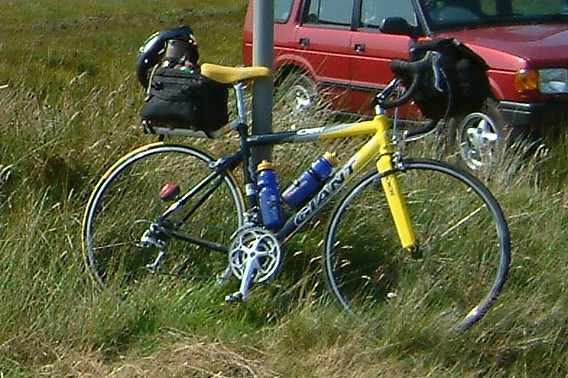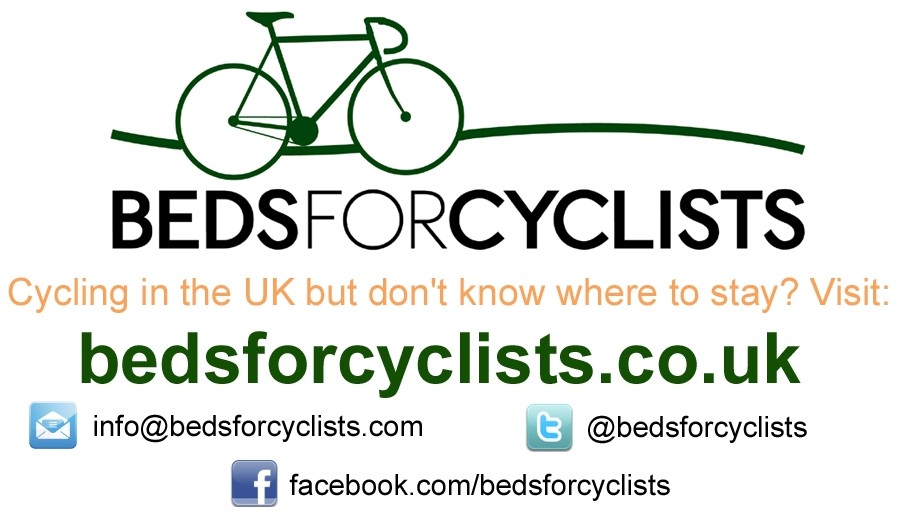Equipment
The Bike
The most important bit! The bike was custom built around a Giant OCR “Compact Aluminium frame and forks.
Chainset – Shimano 105 Rear mech, Front mech and 105 Triple chainrings.
Gearing – Shimano HG70 25-12 tooth cassette and 30 – 42 – 52 chainrings. (We were very glad of those low gears for some of the hills in Devon & Cornwall especially, and at the end of a tiring day sometimes just to give the legs a little less stress.
Wheels – Mavic Cosmos
Tyres – I used Continental Hybrid Bike Ultra Gator Skin 700 x 23c Tyre TYC18357 for the trip, although I have now changed to Continental GP 4 Seasons Vectran Tyre 700c X 23c, Black
Pedals – Shimano 520 Spd Pedal with Specialized SPD shoes.
The Rest of the Kit
Clothing – As far as cycle jerseys and padded shorts are concerned, their are plenty on the market and they are worth the money for the comfort and their quick drying properties. Some other items that I persoanlly find useful are:
Buff Headwear – These are tubular seemless pieces of material in various colours, including some with fleece that you can model into various forms of head and neck wear. Lightwight and worth the money in my opinion. Quite often I just wear mine around my neck as it helps to stop drips of rain getting in and they do have fantastic heat retaining properties.
Cycling Arm Warmers – Lightweight & take no space in your bag, can add that extra warmth when you need it without having to pack another jumper. Used inconjunction with a Gilet
give you lots of options with minimal space required.
Cycling Leg Warmers – As above, saves you carrying a pair of long trousers for cycling meaning you can keep a pair purely for sue in the evening saving them from potentially getting wet.
Luggage – Travelled lightweight with just a single Altura Arran Bar Bag and Atura rear rack bag
(See picture of bike fully loaded.) The rear bag was carried on a seat post rack as my roadbike didn’t have the lugs to fix a full rack. Seat post rack
work very well but you just have to be careful regarding the weight carried as seat post bags come with maximum weight limits. We stayed at YHA’s mainly so no bedding was needed and used the excellent compact trek towel from Lifeventure
to keep space and weight requirements to a minimum.
Tool Kit – Consisted of puncture kit and spare tubes, chain links and link tool, spoke key, multitool (inc allen keys), pliers, spare cables. We shared the tools between us to keep weight down, although we each carried our own puncture kits and 2 spare innertubes. Over the course of the trip repairs between us consisted of the tubes and puncture repair kit, the chain tool / spare links (as we had 2 broken chains), 2 spare tyres, and one wheel replacement. Keith and I also had our spokes retensioned at Chester.
Sundries – Other stuff we took was the usual such as first aid kit, camera, spare set of cycling kit, sunglasses
Food and Snacks – Hydration is very important and you need to keep topping up your fluid levels all the time. Each of us had 2 bottle carriers each mounted on the bike frame, and bottles that carried 750ml of liquid each. I carried one bottle of water and the second one had either water or a carbohydrate drink in it such as Lucozade Sport, depending on what we could find. Food snacks were generally made up with what was available and consisted of either fruit (bananas and the like) or chocolate bars. This supplemented our refreshments stops at café’s or supermarket restaurants which we did at mid morning, lunchtime and mid afternoon. Little and often is the key.
Mapping – My main source of mapping was using the Memory Map electronic maps based on the OS 1 250 000 road atlas of Great Britain. I printed and enlarged the bits appropriate to our route. I also had loaded the appropriate 1 50 000 Landranger sections of the route onto my Compaq IPAQ (times have changed since then!) linked to a bluetooth GPS so if we really were stuck coming into a city like Carlisle or Chester for instance where the 1 250 000 map doesn’t have enough detail, we could call on the fifth member of the team, Gladys the GPS!
I have now moved on from the Compaq iPAQ and have Viewranger OS maps on my Android Mobile phone. This gives me OS maps of the UK and I can buy the map tiles I need for a particular area of the whole of the UK. Failing that you can also purchase a Memory Map GPS device that comes with a handlebar mount in the box. Personally however, I would avoid these as my experience of them is not great. Read my blog, a link follows in this paragraph. You can also buy cycle computers with GPS functionality built in, such as the Garmin Edge 800, although I think the mapping maybe a little bit limited although they do give other cycling related features. If you want a GPS not just for cycling so that you can use it in other activities and maximise its use & investment, a GPS built into a cycle computer may not be the best option for you. I personally use a Satmap Active 10 GPS, in addition to the Android Viewranger app, for walking and in my work with the Mountain Rescue Team. It’s, in my opinion a fabulous piece of kit and very well designed. I did purchase a Memory map Adventurer 3500 GPS before the Satmap, but it is an awful device. Over priced, badly designed and poor follow up service as the forum demonstrates. I have posted a review of both devices on my blog should you wish to look into either device. If you do decide to purchase a GPS, make sure you do your homework first and thoroughly research the features and have a clear idea of how you wish to use it.
Safety – We all wore helmets for a majority of the journey, and Keith and I also had small Handlebar end cycle mirrors which are superb for keeping your eye on whats coming up behind you. Added with lights (including LED safety lights) reflective strips and reflective cycle clothing, this formed our key strategy in staying alive


